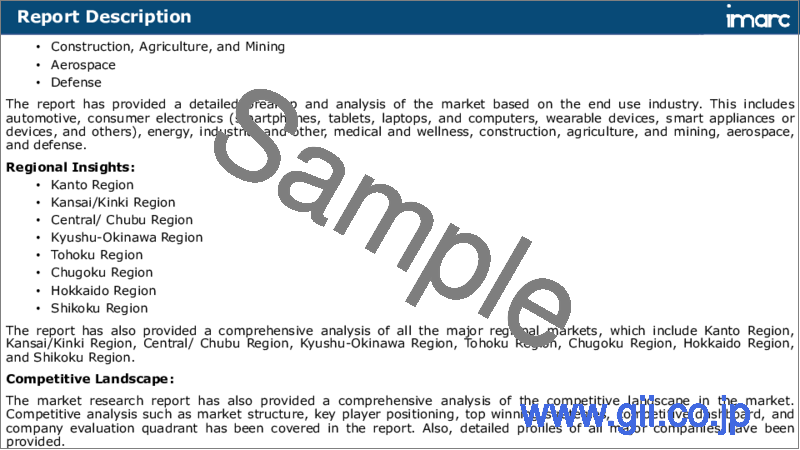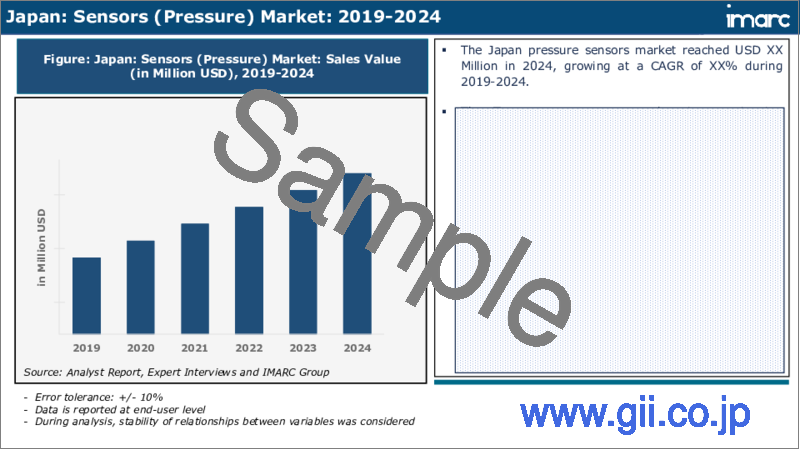|
|
市場調査レポート
商品コード
1609669
日本のセンサー市場レポート:測定パラメータ、動作モード、最終用途産業、地域別、2025年~2033年Japan Sensors Market Report by Parameters Measure, Mode of Operation, End Use Industry, and Region 2025-2033 |
||||||
カスタマイズ可能
|
|||||||
| 日本のセンサー市場レポート:測定パラメータ、動作モード、最終用途産業、地域別、2025年~2033年 |
|
出版日: 2024年12月05日
発行: IMARC
ページ情報: 英文 118 Pages
納期: 5~7営業日
|
- 全表示
- 概要
- 目次
日本のセンサー市場の市場規模は2024年に45億米ドルに達しました。今後、IMARC Groupは、市場は2033年までに1,062億米ドルに達し、2025年から2033年にかけて37.2%の成長率(CAGR)を示すと予測しています。モノのインターネット(IoT)アプリケーションの人気の高まりと様々な技術の進歩が、主に市場成長を牽引しています。
本レポートで扱う主な質問
- 日本のセンサー市場はこれまでどのように推移し、今後どのように推移するのか?
- COVID-19が日本のセンサー市場に与えた影響は?
- 日本のセンサー市場の測定パラメータの内訳は?
- 日本のセンサー市場の動作モード別の内訳は?
- 日本のセンサー市場の最終用途産業別の内訳は?
- 日本のセンサー市場のバリューチェーンにはどのような段階があるのか?
- 日本センサーの主な促進要因と課題は?
- 日本のセンサー市場の構造と主要プレーヤーは?
- 日本のセンサー市場における競合の程度は?
目次
第1章 序文
第2章 調査範囲と調査手法
- 調査の目的
- ステークホルダー
- データソース
- 市場推定
- 調査手法
第3章 エグゼクティブサマリー
第4章 日本のセンサー市場-イントロダクション
- 概要
- 市場力学
- 業界動向
- 競合情報
第5章 日本のセンサー市場情勢
- 過去および現在の市場動向(2019年~2024年)
- 市場予測(2025-2033)
第6章 日本のセンサー市場:測定パラメータ別の内訳
- 温度
- 圧力
- レベル
- フロー
- 近接性
- 環境
- 化学薬品
- 慣性
- 磁気
- 振動
- その他
第7章 日本のセンサー市場:動作モード別の内訳
- 光学
- 電気抵抗
- バイオセンサー
- 圧電抵抗型
- 画像
- 静電容量式
- 圧電
- ライダー
- レーダー
- その他
第8章 日本のセンサー市場- 最終用途産業別内訳
- 自動車
- 家電
- エネルギー
- 工業およびその他
- 医療と健康
- 建設、農業、鉱業
- 航空宇宙
- 防衛
第9章 日本のセンサー市場:競合情勢
- 概要
- 市場構造
- 市場プレーヤーのポジショニング
- 主要成功戦略
- 競合ダッシュボード
- 企業評価象限
第10章 主要企業のプロファイル
第11章 日本のセンサー市場:業界分析
- 促進要因・抑制要因・機会
- ポーターのファイブフォース分析
- バリューチェーン分析
第12章 付録
Japan sensors market size reached USD 4.5 Billion in 2024. Looking forward, IMARC Group expects the market to reach USD 106.2 Billion by 2033, exhibiting a growth rate (CAGR) of 37.2% during 2025-2033. The rising popularity of the Internet of Things (IoT) applications, along with the various technological advancements, is primarily driving the market growth.
Sensors, often regarded as the eyes and ears of modern technology, play a pivotal role in interpreting and interacting with the world around us. These intricate devices detect specific physical or environmental conditions, converting them into signals that can be read by instruments or users. From simple applications, like thermostats that monitor room temperature, to complex systems, such as autonomous vehicles sensing obstacles, sensors bridge the gap between the physical and digital realms. Their ubiquity in today's tech-driven landscape is undeniable, finding relevance in industries ranging from healthcare and agriculture to aerospace and telecommunications. As technological advancements continue, the demand for more accurate, miniaturized, and energy-efficient sensors is on the rise. They stand as crucial components in the ever-expanding Internet of Things (IoT) ecosystem, enabling smarter homes, cities, and workplaces. With the confluence of artificial intelligence and big data, sensors are not only gathering information but also empowering decision-making, driving innovation, and shaping the future of technology.
Japan Sensors Market Trends:
The Japan sensors market embodies a fusion of tradition and technological evolution, reflecting the nation's commitment to fostering innovation while addressing real-world challenges. As one of the leaders in electronics and automation, Japan's drive towards integrating smart solutions has catalyzed the demand for advanced sensors across various sectors. One pronounced trend is the surge in . IoT applications With the push towards smart cities, homes, and industries, sensors act as the foundational elements, collecting crucial data and facilitating seamless device interconnectivity. Their role in monitoring, automation, and real-time decision-making is transforming Japan's urban and industrial landscapes. Another significant driver is the growing emphasis on healthcare and wellness. The advent of wearable tech, remote patient monitoring, and personalized healthcare solutions has spurred the demand for biosensors, accelerometers, and other specialized sensor types. Moreover, Japan's automotive industry, known for its cutting-edge technology and precision engineering, is increasingly integrating sensors to facilitate autonomous driving, advanced driver assistance systems (ADAS), and enhanced vehicle safety. Environmental sustainability, a priority for Japan, has led to sensors playing a pivotal role in monitoring pollution, predicting natural disasters, and optimizing energy consumption. Government initiatives, promoting research and development in nanotechnology, artificial intelligence, and robotics, further bolster the market dynamics.
Japan Sensors Market Segmentation:
Parameters Measured Insights:
- Temperature
- Pressure
- Level
- Flow
- Proximity
- Environmental
- Chemical
- Inertial
- Magnetic
- Vibration
- Others
Mode of Operations Insights:
- Optical
- Electrical Resistance
- Biosensor
- Piezoresistive
- Image
- Capacitive
- Piezoelectric
- LiDAR
- Radar
- Others
End Use Industry Insights:
- Automotive
- Consumer Electronics
- Smartphones
- Tablets, Laptops, and Computers
- Wearable Devices
- Smart Appliances or Devices
- Others
- Energy
- Industrial and Other
- Medical and Wellness
- Construction, Agriculture, and Mining
- Aerospace
- Defense
Competitive Landscape:
The market research report has also provided a comprehensive analysis of the competitive landscape in the market. Competitive analysis such as market structure, key player positioning, top winning strategies, competitive dashboard, and company evaluation quadrant has been covered in the report. Also, detailed profiles of all major companies have been provided.
Key Questions Answered in This Report:
- How has the Japan sensors market performed so far and how will it perform in the coming years?
- What has been the impact of COVID-19 on the Japan sensors market?
- What is the breakup of the Japan sensors market on the basis of parameters measured?
- What is the breakup of the Japan sensors market on the basis of mode of operations?
- What is the breakup of the Japan sensors market on the basis of end use industry?
- What are the various stages in the value chain of the Japan sensors market?
- What are the key driving factors and challenges in the Japan sensors?
- What is the structure of the Japan sensors market and who are the key players?
- What is the degree of competition in the Japan sensors market?
Table of Contents
1 Preface
2 Scope and Methodology
- 2.1 Objectives of the Study
- 2.2 Stakeholders
- 2.3 Data Sources
- 2.3.1 Primary Sources
- 2.3.2 Secondary Sources
- 2.4 Market Estimation
- 2.4.1 Bottom-Up Approach
- 2.4.2 Top-Down Approach
- 2.5 Forecasting Methodology
3 Executive Summary
4 Japan Sensors Market - Introduction
- 4.1 Overview
- 4.2 Market Dynamics
- 4.3 Industry Trends
- 4.4 Competitive Intelligence
5 Japan Sensors Market Landscape
- 5.1 Historical and Current Market Trends (2019-2024)
- 5.2 Market Forecast (2025-2033)
6 Japan Sensors Market - Breakup by Parameters Measured
- 6.1 Temperature
- 6.1.1 Overview
- 6.1.2 Historical and Current Market Trends (2019-2024)
- 6.1.3 Market Forecast (2025-2033)
- 6.2 Pressure
- 6.2.1 Overview
- 6.2.2 Historical and Current Market Trends (2019-2024)
- 6.2.3 Market Forecast (2025-2033)
- 6.3 Level
- 6.3.1 Overview
- 6.3.2 Historical and Current Market Trends (2019-2024)
- 6.3.3 Market Forecast (2025-2033)
- 6.4 Flow
- 6.4.1 Overview
- 6.4.2 Historical and Current Market Trends (2019-2024)
- 6.4.3 Market Forecast (2025-2033)
- 6.5 Proximity
- 6.5.1 Overview
- 6.5.2 Historical and Current Market Trends (2019-2024)
- 6.5.3 Market Forecast (2025-2033)
- 6.6 Environmental
- 6.6.1 Overview
- 6.6.2 Historical and Current Market Trends (2019-2024)
- 6.6.3 Market Forecast (2025-2033)
- 6.7 Chemical
- 6.7.1 Overview
- 6.7.2 Historical and Current Market Trends (2019-2024)
- 6.7.3 Market Forecast (2025-2033)
- 6.8 Inertial
- 6.8.1 Overview
- 6.8.2 Historical and Current Market Trends (2019-2024)
- 6.8.3 Market Forecast (2025-2033)
- 6.9 Magnetic
- 6.9.1 Overview
- 6.9.2 Historical and Current Market Trends (2019-2024)
- 6.9.3 Market Forecast (2025-2033)
- 6.10 Vibration
- 6.10.1 Overview
- 6.10.2 Historical and Current Market Trends (2019-2024)
- 6.10.3 Market Forecast (2025-2033)
- 6.11 Others
- 6.11.1 Historical and Current Market Trends (2019-2024)
- 6.11.2 Market Forecast (2025-2033)
7 Japan Sensors Market - Breakup by Mode of Operations
- 7.1 Optical
- 7.1.1 Overview
- 7.1.2 Historical and Current Market Trends (2019-2024)
- 7.1.3 Market Forecast (2025-2033)
- 7.2 Electrical Resistance
- 7.2.1 Overview
- 7.2.2 Historical and Current Market Trends (2019-2024)
- 7.2.3 Market Forecast (2025-2033)
- 7.3 Biosensor
- 7.3.1 Overview
- 7.3.2 Historical and Current Market Trends (2019-2024)
- 7.3.3 Market Forecast (2025-2033)
- 7.4 Piezoresistive
- 7.4.1 Overview
- 7.4.2 Historical and Current Market Trends (2019-2024)
- 7.4.3 Market Forecast (2025-2033)
- 7.5 Image
- 7.5.1 Overview
- 7.5.2 Historical and Current Market Trends (2019-2024)
- 7.5.3 Market Forecast (2025-2033)
- 7.6 Capacitive
- 7.6.1 Overview
- 7.6.2 Historical and Current Market Trends (2019-2024)
- 7.6.3 Market Forecast (2025-2033)
- 7.7 Piezoelectric
- 7.7.1 Overview
- 7.7.2 Historical and Current Market Trends (2019-2024)
- 7.7.3 Market Forecast (2025-2033)
- 7.8 LiDAR
- 7.8.1 Overview
- 7.8.2 Historical and Current Market Trends (2019-2024)
- 7.8.3 Market Forecast (2025-2033)
- 7.9 RADAR
- 7.9.1 Overview
- 7.9.2 Historical and Current Market Trends (2019-2024)
- 7.9.3 Market Forecast (2025-2033)
- 7.10 Others
- 7.10.1 Historical and Current Market Trends (2019-2024)
- 7.10.2 Market Forecast (2025-2033)
8 Japan Sensors Market - Breakup by End Use Industry
- 8.1 Automotive
- 8.1.1 Overview
- 8.1.2 Historical and Current Market Trends (2019-2024)
- 8.1.3 Market Forecast (2025-2033)
- 8.2 Consumer Electronics
- 8.2.1 Overview
- 8.2.2 Historical and Current Market Trends (2019-2024)
- 8.2.3 Market Segmentation
- 8.2.3.1 Smartphones
- 8.2.3.2 Tablets, Laptops, and Computers
- 8.2.3.3 Wearable Devices
- 8.2.3.4 Smart Appliances or Devices
- 8.2.3.5 Others
- 8.2.4 Market Forecast (2025-2033)
- 8.3 Energy
- 8.3.1 Overview
- 8.3.2 Historical and Current Market Trends (2019-2024)
- 8.3.3 Market Forecast (2025-2033)
- 8.4 Industrial and Other
- 8.4.1 Overview
- 8.4.2 Historical and Current Market Trends (2019-2024)
- 8.4.3 Market Forecast (2025-2033)
- 8.5 Medical and Wellness
- 8.5.1 Overview
- 8.5.2 Historical and Current Market Trends (2019-2024)
- 8.5.3 Market Forecast (2025-2033)
- 8.6 Construction, Agriculture, and Mining
- 8.6.1 Overview
- 8.6.2 Historical and Current Market Trends (2019-2024)
- 8.6.3 Market Forecast (2025-2033)
- 8.7 Aerospace
- 8.7.1 Overview
- 8.7.2 Historical and Current Market Trends (2019-2024)
- 8.7.3 Market Forecast (2025-2033)
- 8.8 Defense
- 8.8.1 Overview
- 8.8.2 Historical and Current Market Trends (2019-2024)
- 8.8.3 Market Forecast (2025-2033)
9 Japan Sensors Market - Competitive Landscape
- 9.1 Overview
- 9.2 Market Structure
- 9.3 Market Player Positioning
- 9.4 Top Winning Strategies
- 9.5 Competitive Dashboard
- 9.6 Company Evaluation Quadrant
10 Profiles of Key Players
- 10.1 Company A
- 10.1.1 Business Overview
- 10.1.2 Product Portfolio
- 10.1.3 Business Strategies
- 10.1.4 SWOT Analysis
- 10.1.5 Major News and Events
- 10.2 Company B
- 10.2.1 Business Overview
- 10.2.2 Product Portfolio
- 10.2.3 Business Strategies
- 10.2.4 SWOT Analysis
- 10.2.5 Major News and Events
- 10.3 Company C
- 10.3.1 Business Overview
- 10.3.2 Product Portfolio
- 10.3.3 Business Strategies
- 10.3.4 SWOT Analysis
- 10.3.5 Major News and Events
- 10.4 Company D
- 10.4.1 Business Overview
- 10.4.2 Product Portfolio
- 10.4.3 Business Strategies
- 10.4.4 SWOT Analysis
- 10.4.5 Major News and Events
- 10.5 Company E
- 10.5.1 Business Overview
- 10.5.2 Product Portfolio
- 10.5.3 Business Strategies
- 10.5.4 SWOT Analysis
- 10.5.5 Major News and Events
11 Japan Sensors Market - Industry Analysis
- 11.1 Drivers, Restraints, and Opportunities
- 11.1.1 Overview
- 11.1.2 Drivers
- 11.1.3 Restraints
- 11.1.4 Opportunities
- 11.2 Porters Five Forces Analysis
- 11.2.1 Overview
- 11.2.2 Bargaining Power of Buyers
- 11.2.3 Bargaining Power of Suppliers
- 11.2.4 Degree of Competition
- 11.2.5 Threat of New Entrants
- 11.2.6 Threat of Substitutes
- 11.3 Value Chain Analysis





